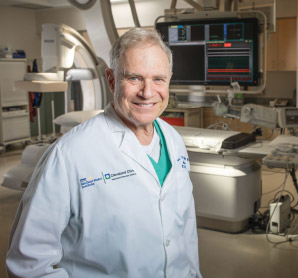Zero Mortality, Zero Stroke Found at 30 Days Post-Procedure

Ron Waksman, MD, designer and principal investigator of the Low-risk TAVR Study
In a major national trial spearheaded by MedStar Heart & Vascular Institute (MHVI), transcatheter aortic valve replacement (TAVR) has demonstrated its
safety and efficacy among patients at low surgical risk when compared with similar patients who had surgical aortic valve replacement (SAVR). Not only were the TAVR outcomes superior to SAVR, but the less invasive approach also resulted in fewer complications.
The findings could have major implications for the treatment of all patients with severe aortic stenosis, whether symptomatic or asymptomatic, says MHVI interventional cardiologist Ron Waksman, MD, designer and principal investigator of the Low-risk TAVR (LRT 1.0) study. He presented its results at the European Society of Cardiology Congress in Munich last August. Results have subsequently appeared in the Journal of the American College of Cardiology.
“Among low-risk patients, TAVR out-performed SAVR in terms of mortality and morbidity, while resulting in shorter hospital stays and lower rates of atrial fibrillation and paravalvular leak,” he says. “Based upon these results, it’s only a matter of time until TAVR receives FDA approval for general use with low-risk patients, probably within the next 12 months or less.”
Eleven medical centers nationwide participated in LRT 1.0, which compared results from 200 low-risk TAVR patients against a control group of 719 low-risk historical patients who underwent SAVR at the same institutions. The results showed zero all-cause mortality and zero in-hospital stroke in the TAVR group compared to 1.7 percent and 0.6 percent, respectively, among the SAVR population.
With the initial LRT study under their belts, Dr. Waksman and his team are now turning their attention to the next steps: determining the optimal anti-coagulation/platelet regimen to prevent post-TAVR bioprosthetic leaflet dysfunction among the low-risk group. Dubbed LRT 2.0, the newest multi-institutional study was launched at MHVI in late July, with more than 30 patients enrolled to date.
LRT 2.0 is one more example of MHVI’s commitment to improve understanding of new and expanded treatment modalities for severe aortic stenosis.
MHVI has participated in every major TAVR trial since the procedure’s debut and is now one of the largest TAVR centers in the United States, performing approximately 400 of the procedures each year.
“Our goal is to have something to offer every patient in our care with advanced heart valvular problems, whether a proven solution or a promising new approach,” Dr. Waksman concludes.









